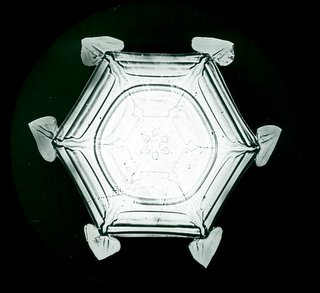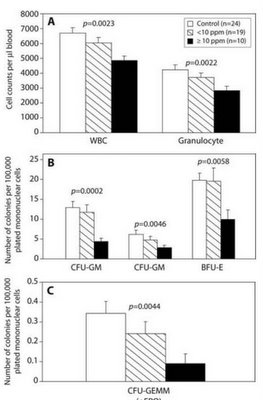A landmark study on benzene toxicity by a collaboration between the U.S. National Cancer Institute and the Chinese Center for Disease Control, Lan et al 2004 was an observational study comparing hematological changes in workers exposed to varying amounts of benzene vapor.
- It demonstrated statistically significant hematological disturbances even for exposure less than 1 ppm, the current U.S. occupational standard.
- It found benzene exposure to assocaited with decreases in hematopoetic stem cells in the blood, in a dose-dependent manner.
Here is Table 1 with just the comparison of CBCPD and flow cytometry results between the control group and the less than 1 ppm group. The other 2 exposed groups are 1 to 10 ppm (110 subjects) and greater than 10 ppm (31 subjects).
Here is Figure 1 comparing the amount of hematopoietic stem and progenitor cells in the circulation between subjects with 0, less than 10 ppm, and greater than 10 ppm of benzene exposure. As explained in the online supplement:
Colonies arising from the most primitive, early progenitor cells are called colony-forming-unit�granulocyte, erythroid, macrophage, megakaryocyte (CFU-GEMM) because the progenitors can give rise to any of these mature cells. Colonies derived from more committed progenitor cells that give rise to reticulocytes and erythrocytes are called burst-forming unit�erythroid (BFU-E), whereas those that give rise to granulocytes and macrophages are called colony-forming unit�granulocyte-macrophage (CFU-GM).
Notes on methods:
- Levels of exposure were measured repeatedly for up to 16 months before hematological measures
- Benzene and toluene air levels were estimated by "the arithmetic mean of an average of two measurements per subject collected during the month prior to phlebotomy" (online supplement)
Notes on stats:
- Population heterogeneity examined with random effects model
- Tests for trends (e.g., trends in changes in WBC count with respect to leveel of benzene exposure) were adjusted by the subject of the covariates { smoking, EtOH, recent infections, and BMI } that is significant (model selection method unclear? not detailed in online supplement either). Level of toluene exposure is also put in the model for continuous covariates since toluene competitively inhibits benzene metabolism.
- Repeated measures adjusted with generalized estimating equation models
Technorati Tags:
China / Harbin /Benzene / Environment disaster / Toxicology / Hematology






No comments:
Post a Comment